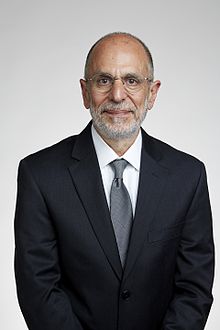Robert Cava
Robert Cava | |
|---|---|
 Robert Cava at the Royal Society admissions day in London in 2016 | |
| Born | 1951 (age 72–73)[3] |
| Alma mater | Massachusetts Institute of Technology |
| Awards |
|
| Scientific career | |
| Fields | Solid-state chemistry[1] |
| Institutions | |
| Thesis | A study of the mobile ions in several binary fast ion conductors (1978) |
| Doctoral advisor | Bernhardt J. Wuensch[2] |
| Notable students | Hemamala Karunadasa |
| Website | chemists |
Robert Joseph Cava (born 1951)[3] is a solid-state chemist at Princeton University where he holds the title Russell Wellman Moore Professor of Chemistry.[4] Previously, Professor Cava worked as a staff scientist at Bell labs from 1979–1996, where earned the title of Distinguished Member of the Technical Staff. As of 2016[update] his research investigates topological insulators, semimetals, superconductors, frustrated magnets and thermoelectrics.[1][5][6]
Education
Cava was educated at the Massachusetts Institute of Technology (MIT) where he was awarded Bachelor of Science and Master of Science degrees in Materials Science and Engineering in 1974 followed by a PhD in ceramics in 1978.[5] His PhD was supervised by Bernhardt J. Wuensch[2] and investigated the electrical mobility of ions in fast ion conductors.[7][8][9]
Career and research
In his career, he has published over 500 peer-reviewed papers, 36 of them in Nature and 8 of them in Science.[citation needed] These papers have been cited over 30,000 times,[citation needed] including his seminal work on Ba2YCu3O9−δ (YBCO), which has been cited almost 1500 times.[10] He holds 15 patents.[citation needed]

Honors and awards
In recognition of his contributions to the fields, he was named fellow of the American Institute of Physics (1988)[11] and elected to the National Academy of Sciences (2001).[12] Acknowledging Cava's achievements, the National Academy of Science specifically pointed to his mastery of the ternary and quaternary oxides that produced materials possessing high-temperature superconductivity. In 1996 Cava received the Bernd T. Matthias Prize for new superconducting materials. In 2001 he became a Fellow of the American Physical Society.[citation needed] He received in 2011 the Humboldt Prize and in 2012 the Linus Pauling Award. In 2014 received Doctor Honoris Causa degree from the Gdańsk University of Technology. In addition to research, Cava's ability to connect with students while teaching has earned him several teaching awards, including the Fall 2002 Excellence in Teaching Award from Princeton University.[5]

He was elected a Foreign Member of the Royal Society (ForMemRS) in 2016.[13]
Personal life
His biography at the Gdańsk University of Technology describes him as a
New Yorker, dedicated supporter of the New York Yankees, passionate astronomer and amateur brewer.[3]
References
- ^ a b "Cava Laboratory: Solid State Chemistry Research Group". Princeton, New Jersey: princeton.edu. Archived from the original on 2016-05-01.
- ^ a b "Cava Lab: Professor Robert J. Cava". princeton.edu. Archived from the original on 2016-03-04.
- ^ a b c "Robert J. Cava (born 1951)" (PDF). Gdansk: pg.edu.pl. Archived from the original (PDF) on 2016-05-31.
- ^ CV in Princeton
- ^ a b c "Robert J. Cava CV: Russell Wellman Moore Professor of Chemistry" (PDF). Princeton, New Jersey: princeton.edu. Archived from the original (PDF) on 2016-05-31.
- ^ Robert Cava's publications indexed by the Scopus bibliographic database. (subscription required)
- ^ Cava, Robert Joseph (1978). A study of the mobile ions in several binary fast ion conductors (PhD thesis). Massachusetts Institute of Technology. OCLC 5881992. ProQuest 302912364.
- ^ Cava, R.J.; Reidinger, F.; Wuensch, B.J. (1977). "Single-crystal neutron-diffraction study of AgI between 23° and 300°C". Solid State Communications. 24 (6): 411–416. Bibcode:1977SSCom..24..411C. doi:10.1016/0038-1098(77)91306-0.
- ^ "Bernhardt J. Wuensch: Chemistry Tree". academictree.org. Archived from the original on 2016-05-31.
- ^ Cava, Robert; et al. (20 April 1987). "Bulk superconductivity at 91 K in single-phase oxygen-deficient perovskite Ba2YCu3O9-δ". Phys. Rev. Lett. 58 (16): 1676–1679. Bibcode:1987PhRvL..58.1676C. doi:10.1103/PhysRevLett.58.1676. PMID 10034505.
- ^ "Robert Cava". Array of Contemporary American Physicists. American Institute of Physics. Retrieved 16 September 2012.
- ^ "Cava, Robert J." Member Directory. National Academy of Sciences. Archived from the original on 2016-03-21. Retrieved 16 September 2012.
- ^ "Professor Robert Cava ForMemRS". London: Royal Society. Archived from the original on 2016-04-29. One or more of the preceding sentences incorporates text from the royalsociety.org website where:
“All text published under the heading 'Biography' on Fellow profile pages is available under Creative Commons Attribution 4.0 International License.” --"Royal Society Terms, conditions and policies". Archived from the original on September 25, 2015. Retrieved 2016-03-09.
{{cite web}}: CS1 maint: bot: original URL status unknown (link)
